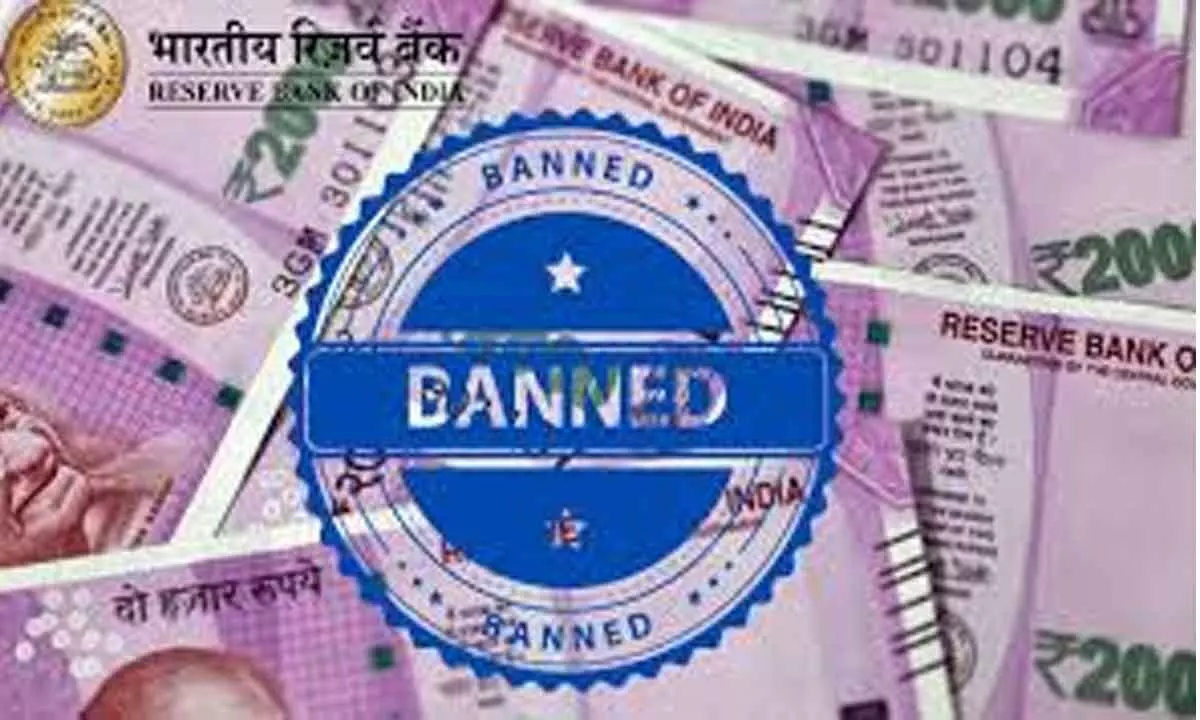Rs 2,000 note ban, a surgical strike or Modi's electoral masterstroke?
Common people will not be impacted by withdrawal of Rs 2,000 currency notes which are not in regular use for quite some time
image for illustrative purpose

Everybody loves currency, the very embodiment of wealth and riches. But all currency notes don't look attractive. The 100 US dollar banknote looks enticing and has a great colour combination. The US government obviously took extra care in designing its most popular banknote as its dollar is the global currency. In India, we have banknotes of seven denominations now, starting from Rs 10. But the most attractive of the seven is the one that comes with Rs 2,000 denomination! That's how I feel as it bears a rich colour combination dominated by pink, has a charm of its own, looks awesome across parameters and stands out clearly when it is clubbed with other currency notes.
Alas, this charming banknote will fade out soon with the Reserve Bank of India (RBI) announcing its withdrawal from circulation on May 19. The announcement came after stock markets closed for the weekend. That way, RBI and the central government took some precautions before the big announcement which could be dubbed as Demonetisation 2.0.
The Rs 2,000 note came into circulation on November 10, 2016, two days after Prime Minister Narendra Modi shocked the nation by banning high-value currency notes with immediate effect. As per RBI data, the circulation of Rs 2,000 notes peaked to Rs 6.73 lakh crore as on March 31, 2018, accounting for a whopping 37.3 per cent of total currency notes in circulation then.
Thereafter, RBI stopped printing these notes and their circulation also came down drastically. As on March 31, 2023, these notes worth Rs 3.62 lakh were in circulation, making up just 10.8 per cent of the total notes. All these Rs 2,000 notes will also go out of circulation as RBI has asked people to deposit them in their bank accounts or get them exchanged before September 30. Though RBI was emphatic that these notes would continue to be a legal tender, it is not likely to be entertained by traders and shopkeepers any longer unless there is any additional gain.
But the trillion rupee question is why has RBI taken this startling decision now, nearly four years after it stopped printing these high-value notes. It's a known fact that usage of the Rs 2000 note has come down. But most of these notes in circulation are believed to be with black money hoarders, some of whom are likely to use them in the upcoming Assembly and General Elections. This withdrawal may reduce that probability. Perhaps, Modi wants to reduce the role of money in these elections as that may enhance BJP's electoral prospects. Sushil Kumar Modi, BJP's senior leader from Bihar, described the decision to withdraw Rs 2,000 notes as the second surgical strike on black money, which is a clear indication of the BJP thinking.
Secondly, the withdrawal decision will definitely elevate Modi's image among common people as the move will be seen as a tough act against rich and black money hoarders. This has happened in the past as well.
The surprise demonetisation of high-value currency notes on November 8, 2016 (Demonetisation 1.0), created cash chaos and caused inconvenience to millions of people as 86 per cent of the currency in circulation became worthless overnight. But the note ban did wonders for Narendra Modi and Bharatiya Janata Party (BJP), the political party he represents. A few months after Modi surprised all with his demonetisation move, BJP romped home in the 2017 Uttar Pradesh Assembly polls with a two-third majority of 325 seats. In fact, BJP did not even declare the chief ministerial candidate in those polls.
Nearly two years after those polls, I travelled across Uttar Pradesh during the 2019 Lok Sabha polls. People on the street were still praising Modi for his 'daring demonetisation move' that, they strongly felt, hit the rich, nouveau riche and political class hard. This image paid rich dividends for BJP in the last General Elections as it could increase its tally in Lok Sabha to 303 in 2019 from 282 in 2014.
So, a similar political benefit for the saffron party can't be ruled out post the latest banknote withdrawal. This could be gauged from the way BJP's political opponents fell into a trap and criticised the sudden withdrawal decision.
West Bengal Chief Minister Mamata Banerjee behaved like a political novice and went on to say that as it had happened in 2016, RBI's latest move would hit common people hard. She seems to have lost touch with ground realities. Common people stopped using these big notes long back as they disappeared from ATMs and there has been a phenomenal increase in digital transactions in India. So, the move will not trouble the common man in any way, but it will definitely put some rich people, politicians and their well-wishers with cash hoards in defence, albeit temporarily.
These people will find a way to exchange their cash pile of Rs 2000 notes with lower denomination ones. Several people did that in 2016. That will be repeated this time as well. Of course, there will be some inconvenience to them and also some additional costs! This clearly shows why it's not easy to weed out black money in India where it has many avatars - political corruption, official corruption, tax evasions and real estate deals.
Nevertheless, it is not going to be cakewalk for BJP in 2024 General Elections as it's aiming for a third consecutive term, a record of sorts.
Price rise, rising inflation and rampant taxes under the GST regime resulted in a perceptible anger against BJP in several parts of the country. Moreover, there is a serious attempt to unite Opposition forces. Is this banknote withdrawal enough to counter these factors or is the BJP having more strategies up its sleeve? Only time will prove it.

